The Localized Method of Fundamental Solution for Two Dimensional Signorini Problems
Zhuowan Fan,Yancheng Liu,Anyu Hong,★,Fugang Xu,★and Fuzhang Wang
1School of Civil Engineering and Architecture,Nanchang University,Nanchang,330031,China
2Nanchang Institute of Technology,Nanchang,330044,China
ABSTRACT In this work,the localized method of fundamental solution(LMFS)is extended to Signorini problem.Unlike the traditional fundamental solution(MFS),the LMFS approximates the field quantity at each node by using the field quantities at the adjacent nodes.The idea of the LMFS is similar to the localized domain type method.The fictitious boundary nodes are proposed to impose the boundary condition and governing equations at each node to formulate a sparse matrix.The inequality boundary condition of Signorini problem is solved indirectly by introducing nonlinear complementarity problem function(NCP-function).Numerical examples are carried out to validate the reliability and effectiveness of the LMFS in solving Signorini problems.
KEYWORDS Signorini problem;localized method of fundamental solution;collocation method;nonlinear boundary conditions
1 Introduction
In 1933,Signorini studied the frictionless contact problem between a linear elastic body and a rigid body.The related boundary condition is expressed by inequality constraints or complementary forms,which is also called the ambiguous boundary [1].Fichera has proved the existence and uniqueness of the Signorini problem in 1964,and began to call this problem Signorini problem [2].The theory of variational inequality was introduced for the first time in 1972,the existence and uniqueness of solution to Signoniri problem are discussed [3].Later in 1985,Glowinski proposed a nonlinear principle of variation,which greatly extended the ways of solving Signorini problem [4].Signorini problem is a special class of nonlinear boundary value problems,which is widely used in science and engineering,such as contract problem [5,6],electro painting problem [7-9] and shallow dam problem [10-12].In order to satisfy the inequality constraints on some parts of the boundaries,the Signorini problems should be subjected to the Dirichlet and Neumann boundary conditions alternately.Compared with the general boundary value problem,the difficulty of solving Signorini problem is to determine the alternate position of Dirichlet and Neumann boundary conditions.Thus,a variety of numerical methods combined with special iterative techniques have been developed to the Signorini problems.
Based on variational inequality and finite element method(FEM),a heuristic asymptotic formula is derived and applied to solve a percolation in gently sloping beaches [10] and electroplating problems [7].Following the same idea,the elastic contact problem is solved by considering variational formulation and FEM [13].On the other hand,a variational inequality on the boundary is proposed to obtain the numerical solution of Signorini problem by considering the boundary element method(BEM)[14,15].Based on the FEM and BEM,a coupled method is proposed to solve the elastoplastic interface problem [16] and the friction contact problem [17].
In recent years,the meshless numerical methods have been popular in solving partial differential equations(PFEs).In general,the meshless numerical methods can be divided into boundary-type and domain-type methods according to the nodes distributions.The boundary type methods only need nodes on the boundary,such as the method of fundamental solution(MFS)[17-19],the Trefftz method [20-22],the boundary knot method(BKM)[23],the Singular boundary method(SBM)[24,25].The MFS for Signorini problems was proposed by Poullikkas et al.in 1998 [12],while Zhang et al.[26] used the boundary element-liner complementarity method to analyze the same problem.Most of the boundary type methods will generate a full matrix,which is difficult to be solved.Meanwhile,the domain-type methods need to distribute nodes inside the computational domain,the radial basis functions collocation method(RBFCM)or the Kansa method was firstly proposed in the 1990s [27].Later the localized approaches were proposed to generate a sparse matrix,such as the RBF finite difference(RBF-FD)method developed with multiquadric(MQ)RBF [28],Reproducing kernel method [29] and so on.The localized domain type methods share the advantages of flexibility [30],and have been applied to many engineering problems [31-35].
Recently,a localized boundary type method has been proposed based on the fundamental solutions.It combines the advantages of both the domain type method and the boundary type method.The LMFS approximates the field quantity at each node by a linear combination of the field quantities of the local nodes.The idea of the LMFS is similar to the localized domain type method [36,37].The fictitious boundary nodes are proposed to impose the boundary condition and governing equations at each node to formulate a sparse matrix in the LMFS.In recent years,Liu et al.[38] investigated the use of the LMFS for the numerical solution of general transient convection-diffusion-reaction equation in both two-(2D)and three-dimensional(3D)materials.Gu et al.[39] applied the LMFS to the numerical solution of problems with cracks in linear elastic fracture mechanics.Following the same idea,the localized boundary knot method(LBKM)and the localized Trefftz method(LTM)were proposed,respectively [40,41].However,these localized boundary type methods have only been applied to the problems with simple exact solutions.More challenging problems are needed.
In this work,the LMFS is further applied to the Signorini problem,where the inequality boundary constraints are treated as the nonlinear complementarity problems(NCPs).By utilizing the Fischer-Burmeister NCP-function,the LMFS yields a system of nonlinear algebraic equations [42,43].
The structure of this paper is organized as follows.Section 2 introduces the problem of Signorini problem.In Section 3,we provide the detailed numerical discretization of the LMFS.In Section 4,numerical examples are given to examine the efficiency and convergence of this method.Finally,some conclusions are summarized in Section 5.
2 The Signorini Problem
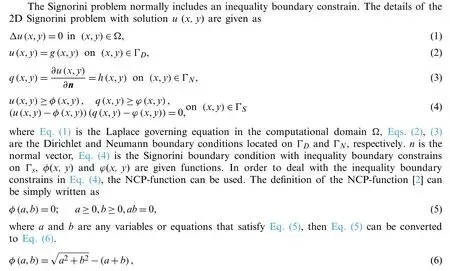
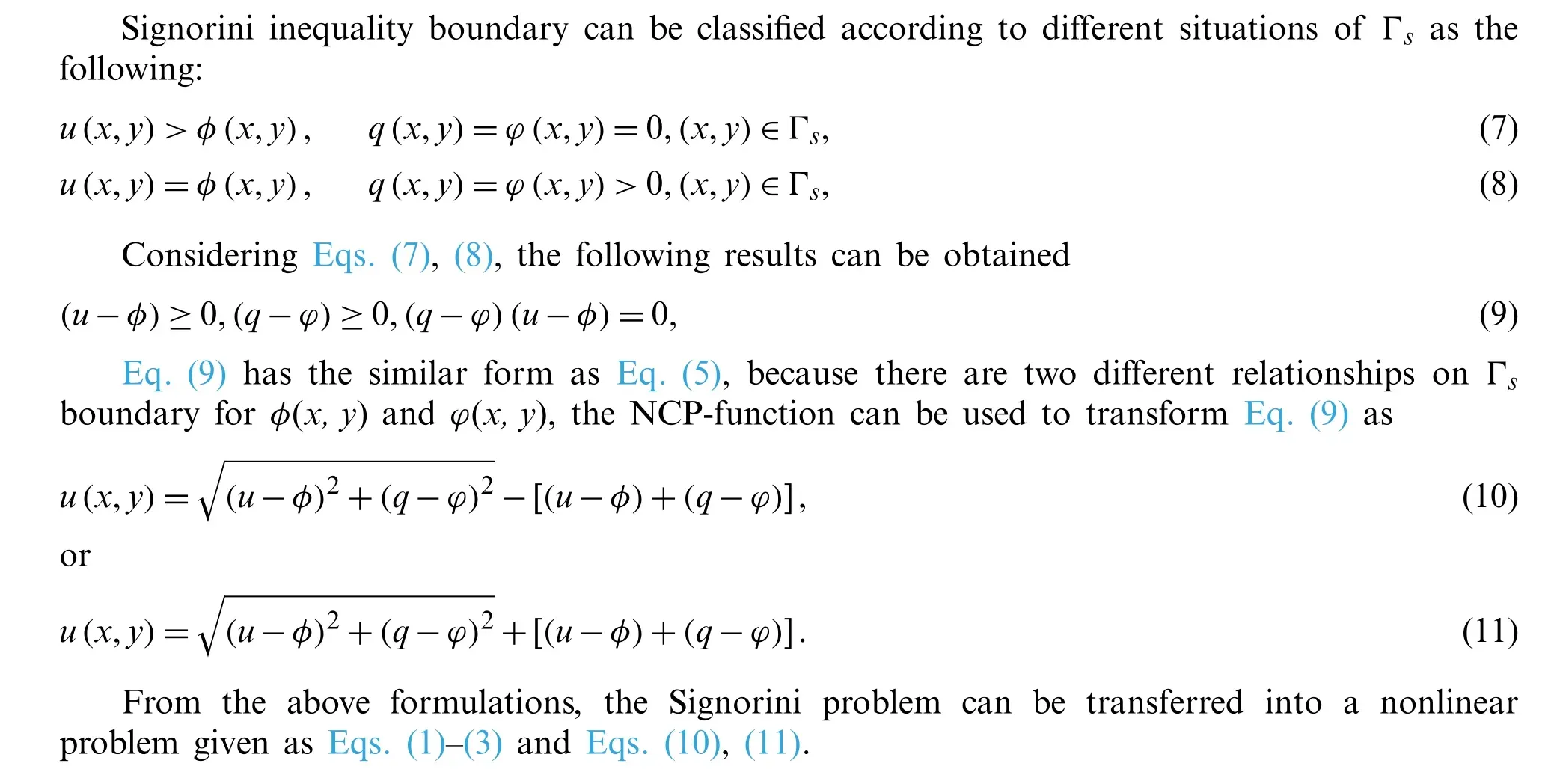
3 Numerical Discretization of the LMFS
In this section,the LMFS discretization is presented based on a simple Laplace problem.As shown in Fig.1,when considering the two-dimensional boundary value problem,N=ni+nbnodes are randomly distributed in the computational domainΩ,and along the entire boundary∂Ω.niandnb=nb1+nb2are the number of internal nodes and boundary nodes,respectively.nb1is the number of nodes alongΓD,andnb2is the number of nodes alongΓN.
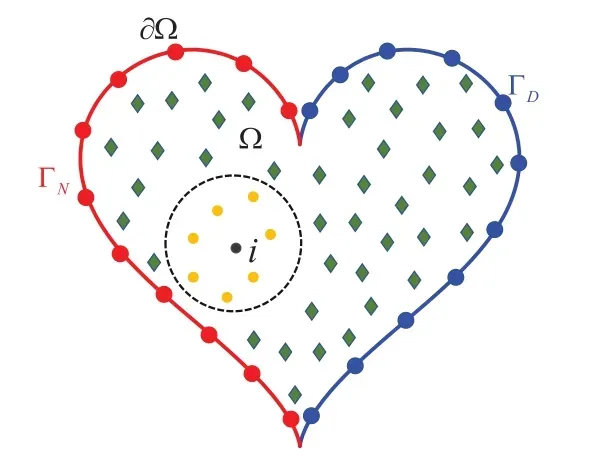
Figure 1:The nodes distribution in the computation domain
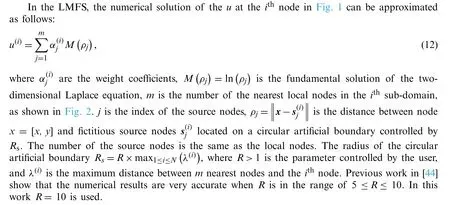

Figure 2:The subdomain at the ith node
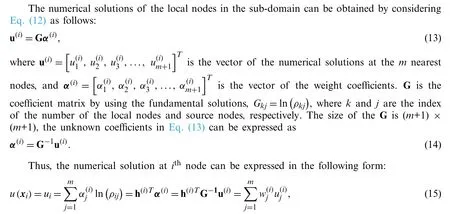
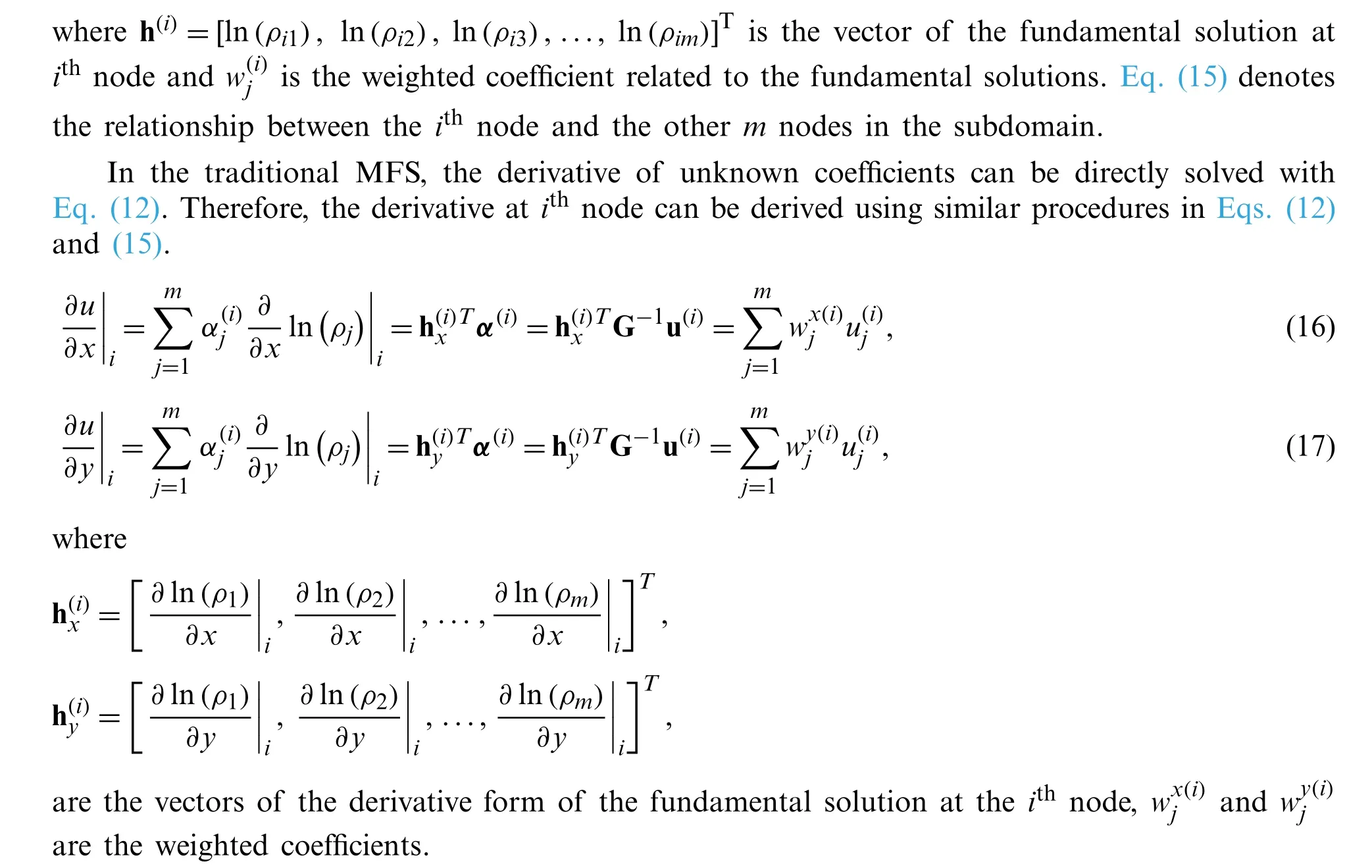
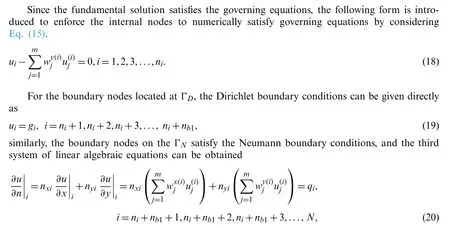
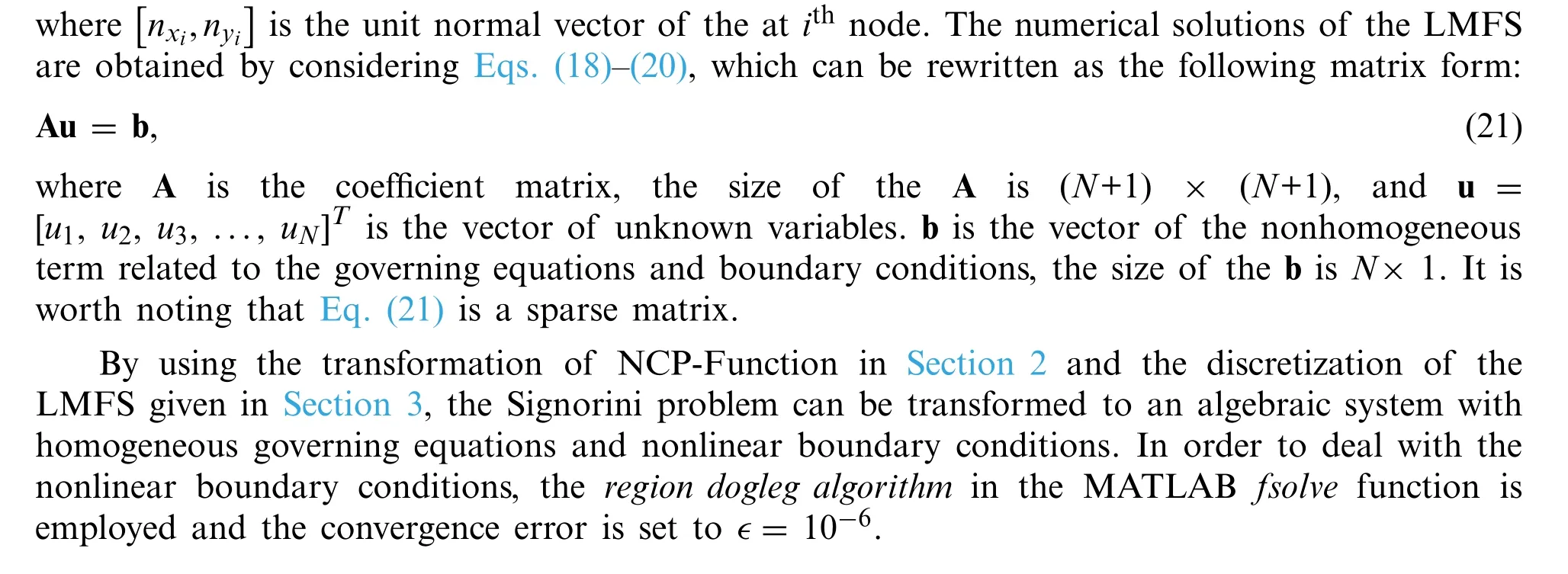
4 Numerical Results and Discussions
4.1 Steady-State Shallow Dam Problem
Here,we consider a well-known steady-state shallow dam problem with respect to infiltration on a gently sloping beach [10-12],where the schematic diagram is shown in Fig.3.The numerical model of this problem can be transformed into


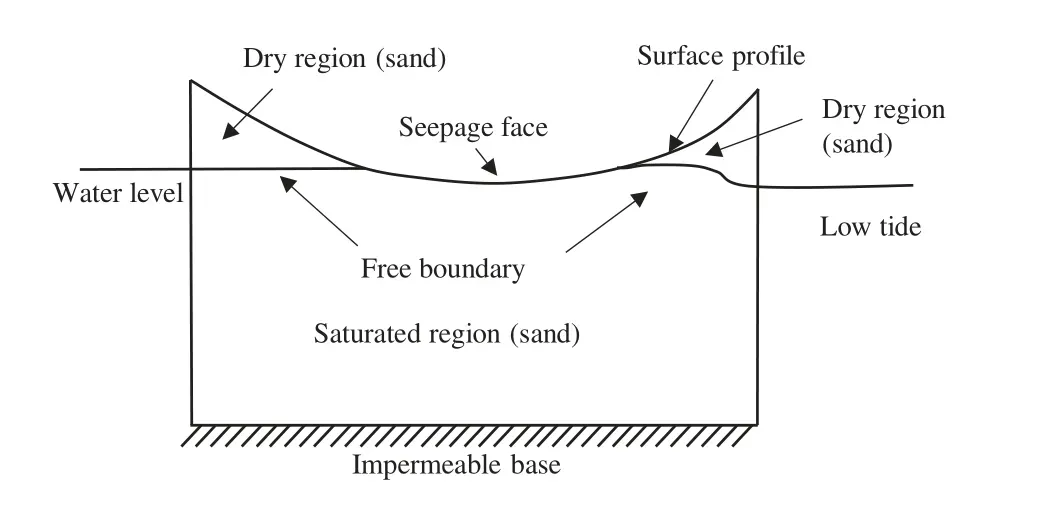
Figure 3:The problem of the shallow dam
Totally,N= 80 andNin= 400 nodes are uniformly distributed on the boundary and in the inner domain,respectively.Five source nodes are used in the LMFS to evaluate the numerical results by considering three different surface profiles in Figs.4 to 6,where the numerical results obtained from the LMFS are compared with the results of the SBM.Although there is no analytical solution,we can find that numerical solutions obtained from the LMFS are in good agreement with the results of the SBM.During our test,the accuracy and stability of the LMFS can be guaranteed when 5 to 10 source nodes are considered.
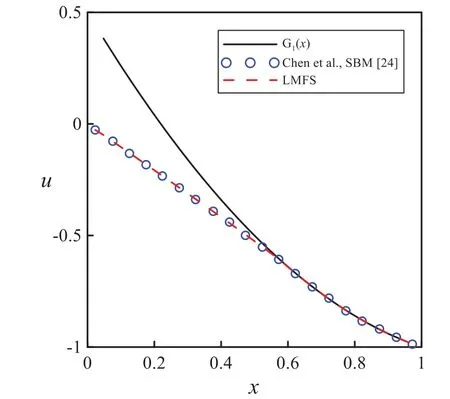
Figure 4:Numerical results of the shallow dam problem with G1(x)

Figure 5:Numerical results of the shallow dam problem with G2(x)
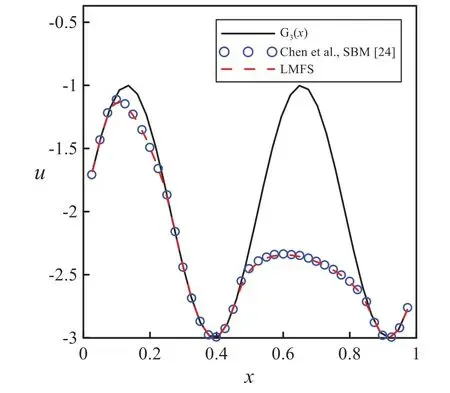
Figure 6:Numerical results of the shallow dam problem with G3(x)
A different number of boundary nodesNis used to show the convergence of the LMFS.Numerical results of the LMFS,the MFS [45],the BIE [46] and the SBM [24] are illustrated and compared in Table 1.From Table 1,it is not difficult to see that the LMFS can obtain the same numerical results with fewer boundary nodes than the other three methods.

Table 1:The solution near the separation node for G1(x)with different N
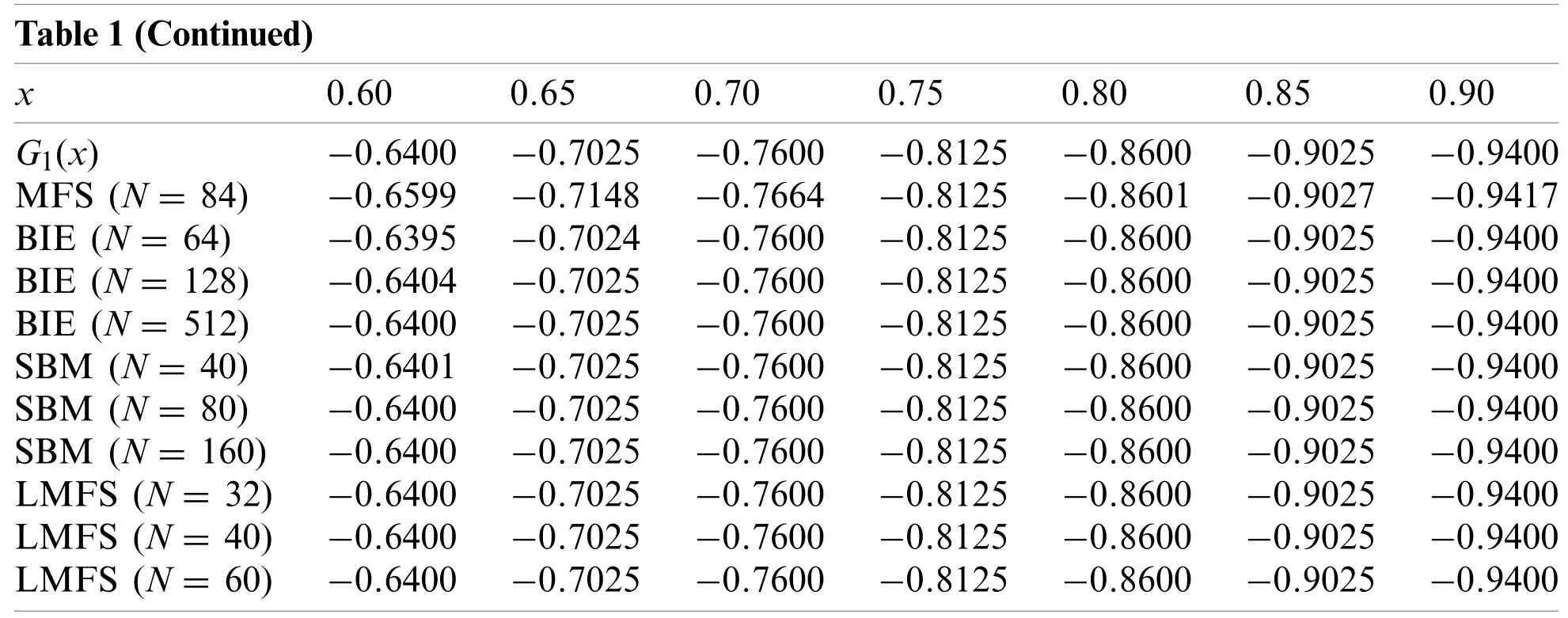
Table 1(Continued)x 0.60 0.65 0.70 0.75 0.80 0.85 0.90 G1(x)-0.6400 -0.7025 -0.7600 -0.8125 -0.8600 -0.9025 -0.9400 MFS(N= 84)-0.6599 -0.7148 -0.7664 -0.8125 -0.8601 -0.9027 -0.9417 BIE(N= 64)-0.6395 -0.7024 -0.7600 -0.8125 -0.8600 -0.9025 -0.9400 BIE(N= 128)-0.6404 -0.7025 -0.7600 -0.8125 -0.8600 -0.9025 -0.9400 BIE(N= 512)-0.6400 -0.7025 -0.7600 -0.8125 -0.8600 -0.9025 -0.9400 SBM(N= 40)-0.6401 -0.7025 -0.7600 -0.8125 -0.8600 -0.9025 -0.9400 SBM(N= 80)-0.6400 -0.7025 -0.7600 -0.8125 -0.8600 -0.9025 -0.9400 SBM(N= 160)-0.6400 -0.7025 -0.7600 -0.8125 -0.8600 -0.9025 -0.9400 LMFS(N= 32)-0.6400 -0.7025 -0.7600 -0.8125 -0.8600 -0.9025 -0.9400 LMFS(N= 40)-0.6400 -0.7025 -0.7600 -0.8125 -0.8600 -0.9025 -0.9400 LMFS(N= 60)-0.6400 -0.7025 -0.7600 -0.8125 -0.8600 -0.9025 -0.9400
Table 2 shows the number of iteration of the BPIM [47],the MFS [46] and the LMFS,and it is easy to see that the LMFS can achieve high accuracy with a smaller number of iterative steps compared with other methods.

Table 1:Number of iteration for the shallow dam problem when τ =10-6
4.2 Electropainting Problem
The well-known electroplating problem [7,36,38] describes the painting process for coated metal surfaces.This problem plays a key role in the automobile manufacturing industry,especially in the application of anti-corrosion coating of automobile body.The principle of the painting process can be simply described as:a workpiece is immersed in the electrolyte paint containing charged ions;then the potential difference between the workpiece and the electrolytic cell is established;Finally,the paint particles are charged and deposited on the surface of the workpiece.The electroplating problem can be described as Signorini problems.
In this case,a Signorini problem of a square field(-0.5,0.5)×(0,1)with potentialuis considered.For simplicity,only the right side of the square field is presented,as shown in Fig.7.The potentialusatisfies:

whereΓs={(x,y):0 ≤x≤0.5,y=1}∪{(x,y):x=0.5,0 ≤y≤1}.Signorini boundaryΓsconstitutes the workpiece to be painted.The exact solution of this problem is given in [7].In this case,the key is to determine the thickness distribution of the boundary parts in(u >0,q+∈= 0).
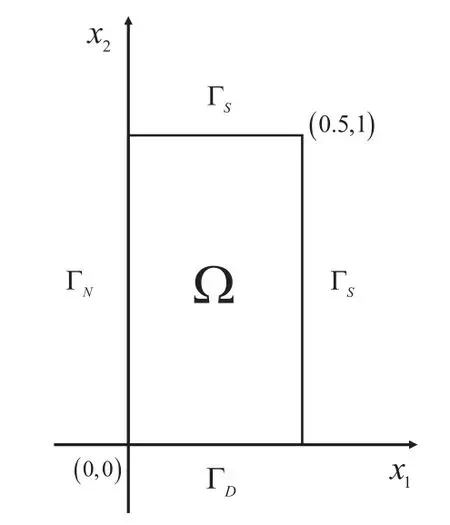
Figure 7:The computational domain of the electropainting problem
Fig.8 depicts the numerical results of the MFS [46],the BEM [26] and the LMFS ofuonΓswhen 80 boundary nodes and 400 interior notes are used.Different values of∈are considered,and the numerical results onΓsare presented with a curve of arc-lengths(s= 0,s= 0.5,s= 1.5,s= 2)starts from corner point(0,0)back to point(0,0)in an anticlockwise direction.We can see from Fig.8 that,the numerical results of the LMFS are very stable and fitting well with the results of other methods.
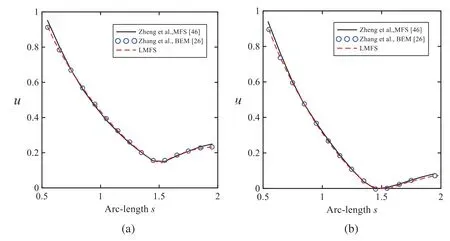
Figure 8:(Continued)
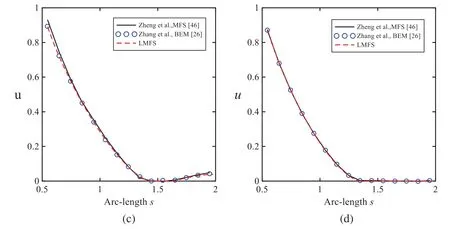
Figure 8:Numerical results with(a) ∈= 0.4,(b) ∈= 0.5,(c) ∈= 0.55,(d) ∈= 0.7
Fig.9 shows the distribution of paint with different∈.The numerical results are obtained by using 80 boundary nodes.Figs.8a and 9a indicate that the workpiece has been completely painted,and the amount of paint at the corner is the smallest.If∈increases,Figs.8b-8c and Figs.9b-9c denote that the paint film near the corner becomes thinner and eventually unpainted.When∈is increasing,Figs.8d and 9d indicate that corner and vertex boundaries are not painted.Although there is no analytical solution,the results of the LMFS can be indirectly validated according to the reasonable physical characteristics.In addition,we can find that the LMFS obtain similar numerical results of the MFS [46,48],the BEM [26,41] and the SBM [24].

Figure 9:Paint distributions of(a) ∈= 0.4,(b) ∈= 0.5,(c) ∈= 0.55,(d) ∈= 0.7
4.3 Double-Connected Domain
As shown in Fig.10a Signorini problem of a double-connected domain [15,24,36,48] is considered

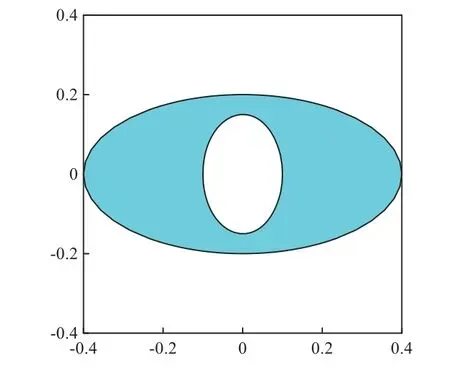
Figure 10:A double-connected computational domain
We takeN= 80 andNin= 400 for the LMFS,and compare the numerical results obtained from the LMFS with the numerical results of the MFS [48] and the SBM [24] in Figs.11 and 12,respectively.It is not difficult to see that the numerical results of the LMFS are in good agreement with numerical results of other two methods.This further indicates that the LMFS can deal with the Signorini problem of the double-connected domain very well.

Figure 11:Numerical u on Γs
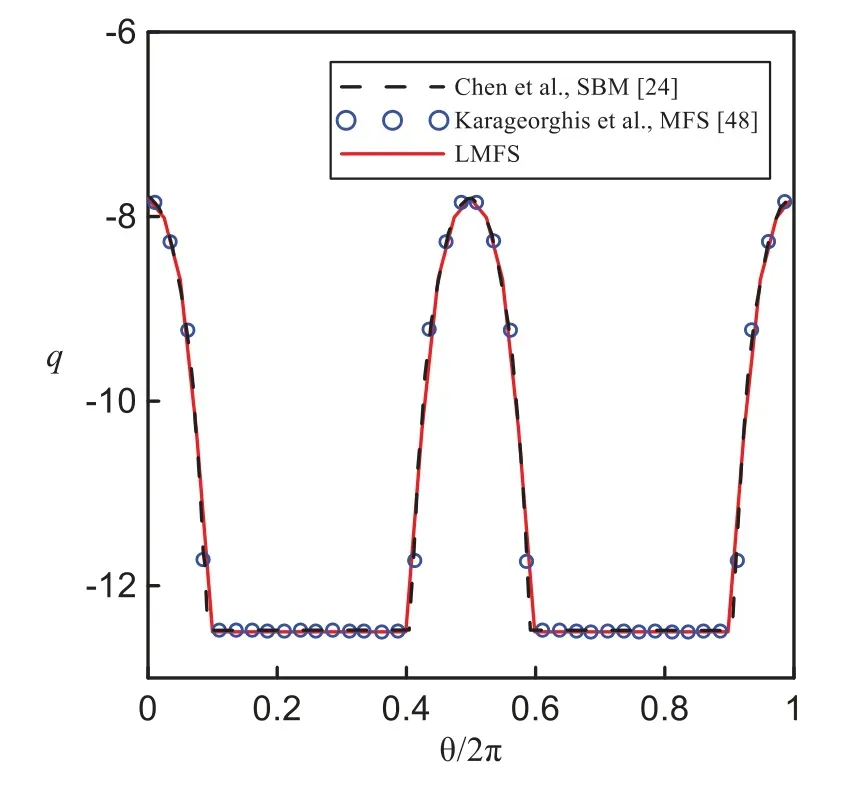
Figure 12:Numerical q on Γs
5 Conclusions
In this paper,the LMFS is further applied to the Signorini problem.The stability of the LMFS is validated by considering several different numerical examples.The numerical results show that the number of source nodes and the initial value have little effect on the number of iterations steps.Comparing the numerical results obtained by LMFS with other methods,the LMFS can get more accurate results with the same number of nodes.The LMFS is more efficient,stable and has a higher convergence rate in dealing with Signorini problem.In our future work,more complicated problems,such as three-dimensional Signorini problems,Seepage problems,obstacle problems will be considered.
Funding Statement:The third author is supported by the National Science Foundation of China(No.52109089).The fourth author is very thankful for the support of Post Doctor Program(2019M652281),Nature Science Foundation of Jiangxi Province(20192BAB216040).
Conflicts of Interest:The authors declare that they have no conflicts of interest to report regarding the present study.
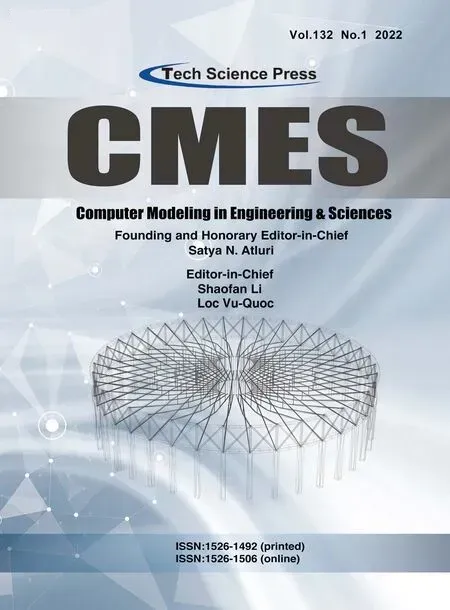 Computer Modeling In Engineering&Sciences2022年7期
Computer Modeling In Engineering&Sciences2022年7期
- Computer Modeling In Engineering&Sciences的其它文章
- Introduction to the Special Issue on Computational Mechanics of Granular Materials and its Engineering Applications
- Low Carbon Economic Dispatch of Integrated Energy System Considering Power Supply Reliability and Integrated Demand Response
- State Estimation of Regional Power Systems with Source-Load Two-Terminal Uncertainties
- Interval-Valued Neutrosophic Soft Expert Set from Real Space to Complex Space
- A Frost Heaving Prediction Approach for Ground Uplift Simulation Due to Freeze-Sealing Pipe Roof Method
- Seed-Oriented Local Community Detection Based on Influence Spreading
